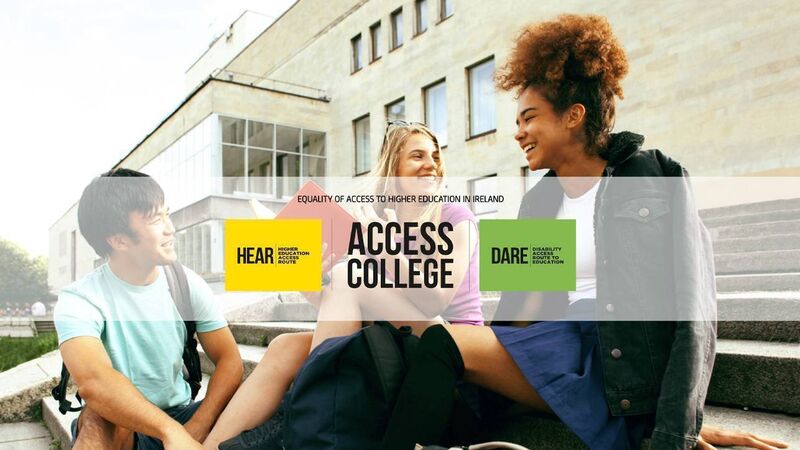Hear and Dare schemes help to improve access to college for all

The Higher Education Access Route (HEAR) and the Disability Access Route to Education (DARE) schemes aim to improve access to third-level education.
Colleges in recent years have prioritised recruiting students from all walks of life, as they have committed to becoming more representative of society at large.
At the same time, evidence shows us that students who are at a disadvantage socio-economically, or who have a disability, face greater obstacles when it comes to progressing on to higher education.
For this reason, we have the Higher Education Access Route (HEAR) and the Disability Access Route to Education (DARE), two schemes aiming to improve access to third-level education.
Importantly, they operate completely separate to maintenance grants or financial assistance, running more like admissions schemes to help students who may not traditionally go on to third-level education.
Through these schemes, reduced points places are offered to school leavers. Students who qualify for HEAR, DARE, or both schemes in some cases, may be offered a course of study even if their total Leaving Cert score is lower than the general admissions cut-off.
Every college and university that takes part reserves a number of places to offer eligible students at reduced Leaving Cert points; However, students still need to meet the minimum entry requirements and any specific programme requirements before being considered.
The reduced points depends on a number of different factors, including the overall number of places on a course, the number of reserved HEAR and DARE places on the course, and the number of eligible students competing for the reduced places.
On some higher education institutions’ websites, you can find more information on the number of reduced points, as well as the method they use for selecting eligible students.
Students who qualify for both HEAR and DARE are prioritised by colleges when it comes to allocating these places.
Students who qualify may also be offered extra support and assistance by their higher education institution throughout their academic studies.
This includes support such as help with study skills, mentoring, or guidance from student advisors.
Specifically tackling education disadvantage, the HEAR is open to students from socio-economically disadvantaged backgrounds.
In order to qualify for the HEAR scheme, students must meet a range of financial, social and cultural indicators.
The DARE is a similar alternative admissions scheme open to students who, as a result of having a disability, have experienced additional educational challenges. The majority of colleges operate both schemes.
In 2020, almost one in five students who applied to the CAO were assessed for DARE and or HEAR eligibility, with more than 11,570 places offered to these applicants across the entire Irish higher education sector.
The demand for the DARE scheme has increased year on year. From 2019 to 2020, the number of applications to DARE grew by 7.5%.
In 2020, 4012 individual applicants to DARE received an offer of a place in higher education, representing a 27.6% increase on the number of offers made in 2019. Of this, 3,146 students applicants accepted their offer.
DARE is for school leavers under the age of 23 as of January 1, 2022, who have been educationally impacted as a result of their disability.
Applicants can present with an Irish Leaving Cert, A-Levels and other EU qualifications.
Likewise, HEAR is open to school leavers under the age of 23 as of January 1, 2022. Students must meet a range of financial, social and cultural indicators in order to qualify.
In order to qualify for the scheme, the student must come from a family whose income is less than €45,790. This income threshold is higher for families of more than three children, or if there are two or more family members already at college.
At the same time, two other ‘indicators’ must also be met in order for a student to qualify for HEAR, including medical card status, social-welfare payments, socio-economic group, disadvantaged status of school or local area and the occupation status of a parent or guardian.
There is a separate range of criteria that a student must meet to qualify for DARE.
This is assessed through an educational impact statement which needs to be completed between the student and their school.
Here, a student provides details of how their disability impacted on their second level experience.
A combination of two of the six criteria must be met, including any additional supports or interventions already provided at schools or in exams, an impact on attendance or exam results or the ability to take part in extracurricular activities.
Students who are eligible to apply for either HEAR, DARE or both should start working with their school as early as possible, as there is quite a bit of necessary paperwork that needs to be submitted.
For mature students, or students applying on the basis of further education and training results, there are different admission routes than HEAR or DARE which usually can be found on college websites.
Students who wish to apply must apply to CAO by 5pm on February 1.
By March 1, students must indicate their wish to be considered for DARE by ticking ‘Yes’ to Question 1 and complete Section A of the Supplementary Information Form (SIF) on www.cao.ie.
Students who wish to apply for HEAR must complete all elements of the application form by 5pm on March 1.
Further information on the whole process, as well as helpful downloadable handbooks are available on www.accesscollege.ie












